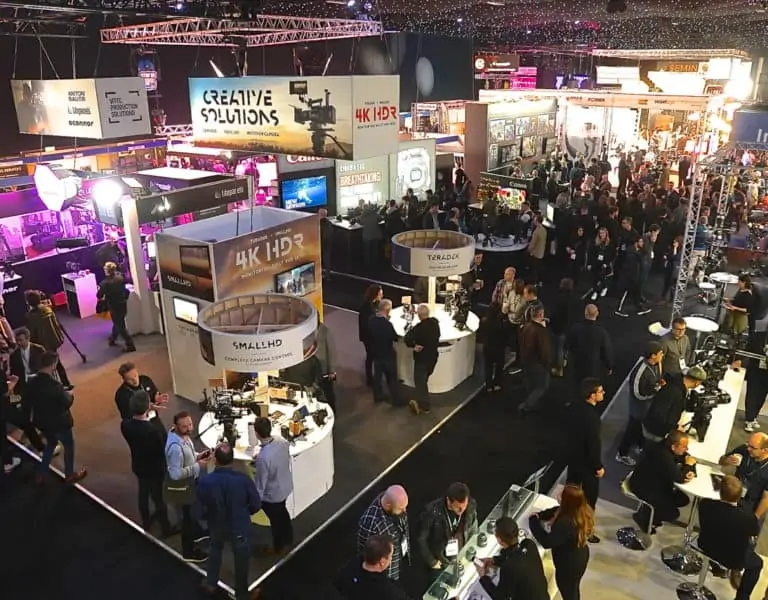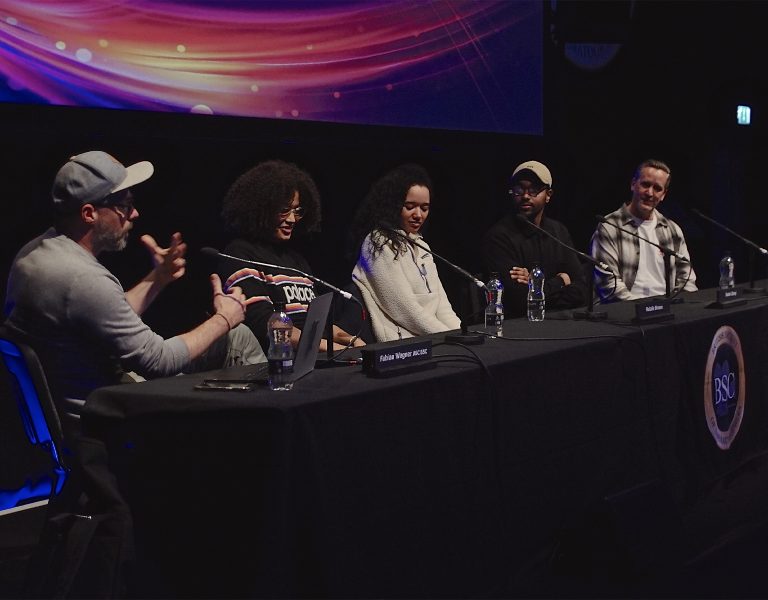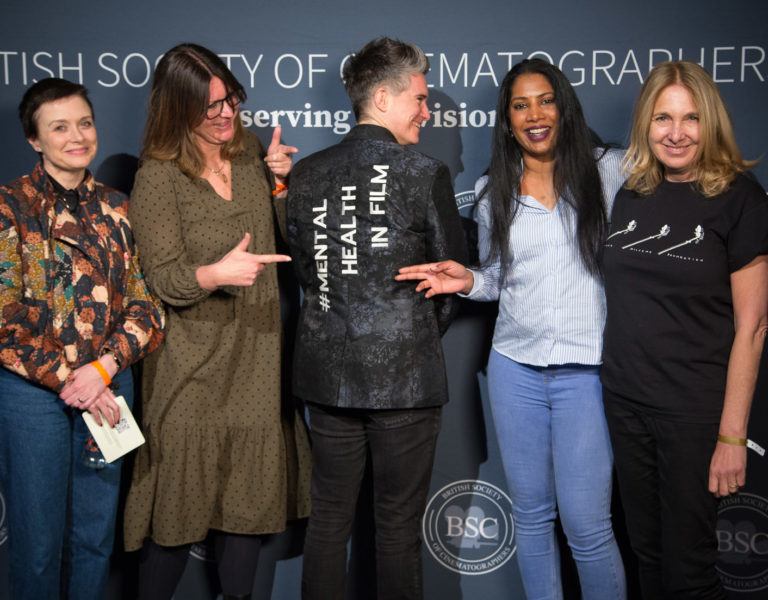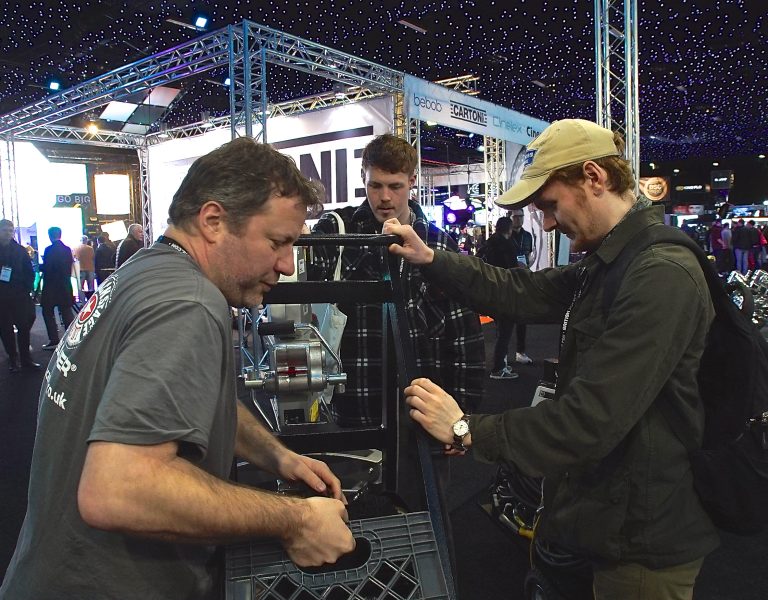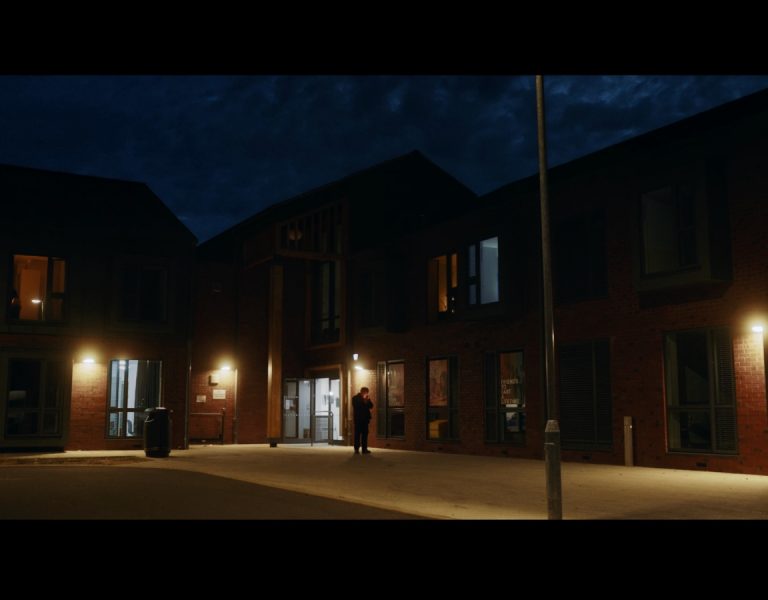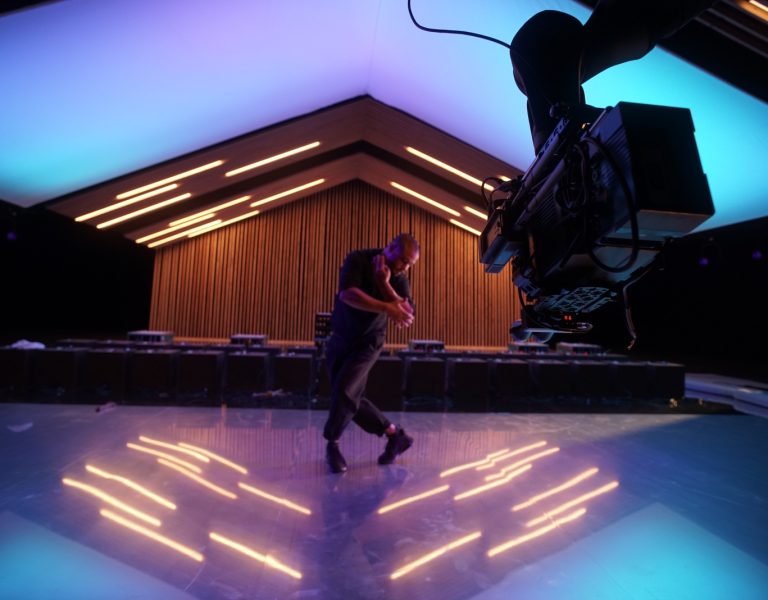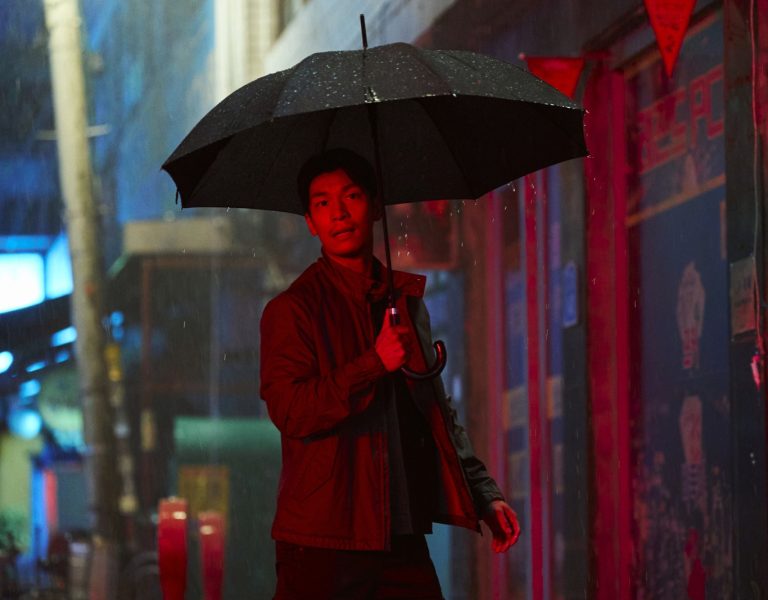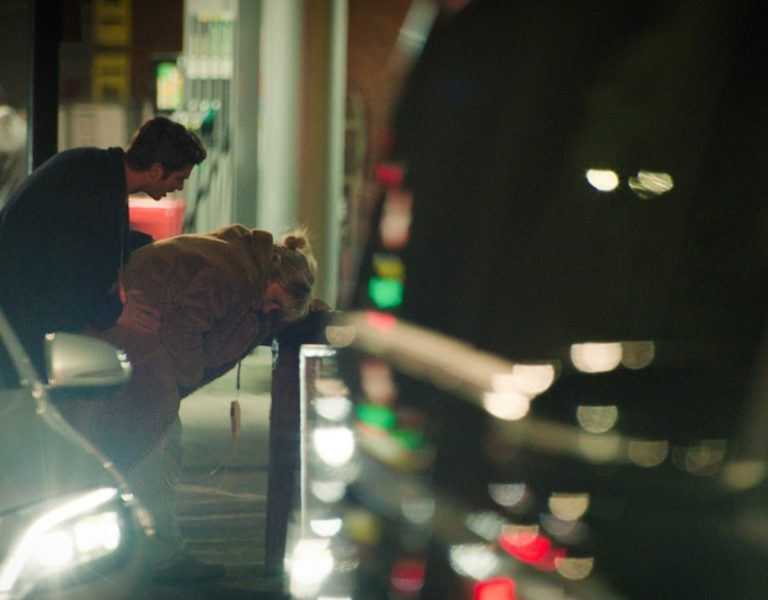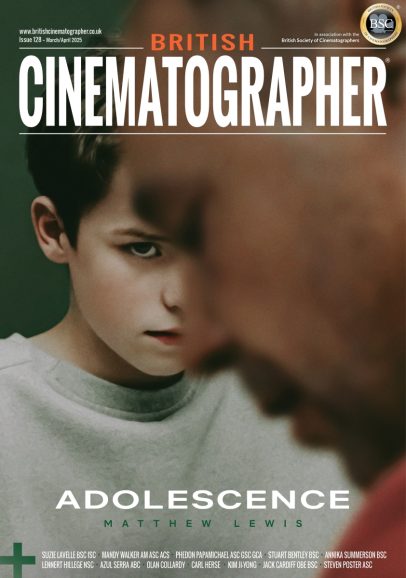CINEMATIC SHOWCASE
Relive the action of BSC Expo 2024 with our rundown of the latest technologies and innovations we can look forward to seeing on set in 2024 and beyond.
It’s a sign of success that the Evolution exhibition centre in London’s Battersea Park always seems slightly too small for the BSC’s annual show.
It’s no surprise to find the event dedicated to single-camera production, but despite that laser focus, this year’s show drew a crowd dense enough to make Steadicam first-timers very cautious as they took advantage of Tiffen’s demonstration rig. What’s clear, though, is that after a whirlwind couple of decades involving huge changes in camera and lighting, those transitions could be seen as nearing some sort of conclusion. The crowd seemed hungry to discover if anything so fundamental might be around the corner again.
RENTAL HOUSES
On the approach to the venue, lights gleamed through the trees of Battersea Park from the exhibit of Sunbelt Rentals, which is a difficult company to sum up; it will supply more or less any item of hardware in the field of camera, lighting, and grip, and much more besides. Film and TV is just one branch of a business perhaps most famous for construction plant, and the name will be new to many in the UK. The company’s presence was based on the acquisition of names like Alpha Grip, PKE Lighting, Media Access Solutions and MovieTech. Combined with the sheer scale of the parent organisation, that should make it capable of handling the largest productions around – or probably several of them, all at once.
As independent rental house Pixipixel is committed to improving sustainability practices, the carbon-neutral business works hard to reduce its emissions swiftly, while offsetting measured emissions. Aligning with this ethos, at the heart of Pixipixel’s showcase was the industry’s load carrying hybrid generator. Their 160kW hybrid is an 18-tonne load carrying generator re-engineered to provide sustainable power on-location, featuring an intelligent switching capability, automatically activating the generator to recharge the battery when it is running low.
Shift 4 highlighted its new ‘Cine’ presence at the Expo, reaffirming the rental house’s dedication to the film and HETV community. “We are trying to offer something different, something to add value to our brand, to make us stand out from the crowd,” Shift 4’s Raff Filomeno told us.
He also pointed out the company’s innovative Special Optical Projects division, where the lens engineering team is developing unique glass to offer DPs more creative choice and freedom. These include the Hydra System, a lens relay system on display at their booth which allows for objects to be placed behind most PL and LPL lenses; directly in the path of the image plane of the lens. The team has experimented with custom-made filters using warped glass, resins and liquids – “but effectively we can place whatever anyone can think of behind the lens, space permitting,” added Filomeno.
One Stop Films took to BSC Expo with a load of impressive gear. The East London rental house came armed with an array of rare and unique optics including anamorphic, vintage, large format, probe and specialist glass.
CAMERAS
Red’s new V-Raptor X cameras appear to be an expansion of the company’s global shutter technology into a full-frame sensor. It’s easy to overlook the significance of this, considering that there has been practically no global-shutter cinema camera of any kind since the days of 2/3” three-chip CCD cameras like Viper, Blackmagic’s early 4K Ursas and late-era CCD-based designs like Digital Bolex.
The lack of rolling-shutter wobble is welcome, especially in VFX-heavy projects, although the ability to tolerate xenon strobes, LEDs and firearms which may create very short-duration flashes is no bad thing either. The camera launches with another interesting feature which relies on some heavy-duty post production, taking two exposures per frame with different shutter speeds for highlight protection. The company’s previous HDRx feature did something similar, though it could be defeated by even limited motion in the frame. The new approach leverages a workstation’s compute power to compensate for motion, yielding a convincing high dynamic range result.
Red accepts that the feature will never be entirely proof against material with very fast-changing content, but it’s certainly an advancement. A dedicated photographic puritan might raise an eyebrow, but the image processing pipeline in most single-chip cameras has always involved a lot of mathematical processing, and this is perhaps just a more visible example of computational photography at work.
Options in the really-big-chip world broadened when Blackmagic released its Cinema Camera 6K at last year’s IBC. This is something of a departure given it lacks the word “pocket” but the layout is akin to Blackmagic’s more hand-portable designs. Perhaps the biggest news other than the sensor is the adoption of the L mount, which is already perhaps the world’s most successful attempt at a standard way to join bits of glass to bits of electronics. It’s shallow and wide, supporting more or less any lens ever made given an appropriate adaptor.
One of Blackmagic’s greatest assets is its control of both the camera and post-production software, and the integration of Blackmagic Raw is what makes things like the 12K Ursa Mini possible. As a purely practical matter, a 6K full-frame sensor is interesting for many reasons, not least of which is that it presents the opportunity to shoot a 4K, approximately Super-35mm-sized frame with a huge amount of look-around. It’s far from the first camera to offer that, but it’s a powerful feature for such a portable and affordable device.
Sony’s exhibit was filled with people taking a long look at the Burano, which shipped shortly after the show. Between that and the FX range, Sony has a camera for practically every budget, and the splash made by The Creator and its use of the modest FX3 camera is still fresh in the minds of many.
Alongside its camera system, Sony showed Verona, an update to the company’s Crystal LED line of video wall panels. The new panels are offered in 1.56 or 2.31 pitch, although perhaps the main feature is Sony’s dedication to achieving high contrast by minimising reflections. The original Crystal LED panels were superb in this regard and Sony is keen to emphasise the potential power savings of Verona over less-efficient competitors.
Panavision was once again a focal point of the show, with its vintage train setup against an LED wall. As well as manning the busy bar, the brand’s lens technicians helped visitors get hands-on with lenses like the Ultra Panatar II anamorphics and VA spherical primes. On proud display was the Panaflex System 65 camera, used for 2023’s smash hit Oppenheimer.
LENSES AND FILTERS
Over at Red, the V-Raptor was shown with a Cooke Varotal/i 30-95mm T2.9 zoom, and we also discover that it’s possible to fly an Alexa 35 with the 50mm Anamorphic/i T2.3 on a DJI Ronin 2 gimbal, which is a lot of picture on such a nimble platform. Cooke’s work featured on a lot of other exhibits, including those of Sony, Blackmagic and Tiffen. Notably, Ovide, the company behind a reincarnation of the widely adored Convergent Design Odyssey, chose to show its monitor-recorder alongside an Alexa with a Cooke lens.
Canon dedicated the lion’s share of its exhibit space to a virtual production setup to demonstrate its built-in lens encoding, which is sufficiently well-integrated to avoid burying the front end of the camera in boxes and cabling. The company’s range of Flex Zooms nestled nearby in a display case – but the part of the company’s lineup likely to shift the most units is probably one of its hybrid stills-video lenses, the RF 24-105 f/2.8 L. Similarly specified lenses are not uncommon, but the benefits of a shallower mount are clear: it’s smaller and lighter than the equivalent EF mount lens might have been. That’s no bad thing whether you’re a YouTuber or a blockbuster in search of a small, capable lens for a special occasion.
Pride of place in Leitz’s lineup was taken by a new 150mm lens, the most recent addition to the Elsie set. The company offers seven different named ranges, with Elsie described as creating a “noticeable falloff” in the corners, contrasting with, say, the Hugo set, which is designed for compactness and to look more like Leica M. The Elsie is not held to the same goals of size and weight as the Hugo, and as such Elsie is able to maintain a T2.1 all the way from 25mm to the new 150. That’s – well – a lot, especially with full-frame coverage.
Laowa’s anamorphic zooms, the Nanomorph 1.5:1 series, are pretty clearly built for convenience. With Super-35 coverage and a 1.5:1 compression factor, they’re tailor-made for people looking to (literally) squeeze a ‘scope picture onto a Super-35 digital sensor without wanting to spend nice-car amounts on each lens. The company is inviting people to pre-order on Indiegogo, which means it’s difficult to comment on performance, but in the end it’s an anamorphic: it’s supposed to be interesting. The 1.5:1 compression factor might work best on sensors squarer than widescreen, although there’s an argument that 1.33:1 lenses often have only subtle anamorphic artefacts, sensors now have plenty of resolution to crop, and Laowa’s decision therefore represents a good compromise.
Elsewhere in the field of interesting glass, True Lens Services needs almost no introduction. Innovation in rehousing inevitably involves figuring out new ways to turn classic photography lenses into tools for film crews, and TLS showed its newly-rehoused Zeiss Contax set. Usually, the company doesn’t hold stock – clients must bring their own lenses to rehouse – but having recently developed this new line, the company is looking to shift the sets it used to prototype the process, so anyone who wants a set can likely have one. TLS is also working on Zeiss Standard Speeds, which it expects to be able to offer by the end of the year.
Similar thinking is behind much of the work done by IB/E Optics, which breaks down into two broad churches: converters and expanders made with immense precision and care to provide the most transparent results possible, and gleefully creative filters containing almost anything that can be sandwiched between a couple of sheets of glass. The success of All Quiet on the Western Front at last year’s Academy Awards has pushed the company’s involvement in the Blackwing7 lens series into even greater prominence. It’s confirmation, if any was needed, of the world’s enthusiasm for real-world optical effects, free of limits to dynamic range, colour gamut or battery life.
A highlight of the show for Fujinon was the UK debut of the HZK24-300mm PL Mount Zoom Lens, surely a hit with wildlife filmmakers in particular. Indeed, Emmy-winning documentary filmmaker and cinematographer Tom Martienssen led a first look at the lens as part of CVP’s presentation line-up on the Friday of the show. The brand also showcased the GFX100 II and the latest 5th Generation X Series cameras, the X-H2S – both displayed with MKX cine lenses.
A highlight of Zeiss’s busy stand was its Nano Prime Lenses. These lightweight cinema lenses, available in six focal lengths, combine top performance with a compact size, ideal for cinematographers at all stages of their career. High-speed and full-frame, they enable images with an extremely shallow depth of field, even in the wide-angle range, and enjoy elegant bokeh and harmonious fall-off.
LIGHTING
Multi-kilowatt options are no longer a surprise, with Godox’s MG2400Bi lighting up the mezzanine above the show floor. The company’s exhibit also featured a prototype full-colour version of its flexible flat panels. They inevitably lack the sheer power density of LED hard lights, but flexible panels have been a popular route to big, soft sources for less power, space, gear and time. There are other full colour mixing flexible panels, but the alternatives have been rare and expensive.
Nanlite has been exhibiting its cluster of four Evoke 2400B bi-colour lights since at least NAB last year. We’re told the 9600-watt combination approximates an 18kW HMI, performance which is probably dependent on both LED efficiency and the improved effectiveness of what’s effectively a PAR reflector over a Fresnel. It’s possibly a compromise of beam quality in pursuit of sheer power, but it’s certainly a big, impressive combination nonetheless. Nanlite’s range of full-colour-mixing panels, PavoSlim, was shown in new shapes and sizes – less spectacular, perhaps, but likely relevant to more people.
Aputure showed high-power options with the Electro Storm XT26 and CS15. Like Godox’s big light, the XT26 has variable colour temperature and green-magenta shift. Aputure is also one of very few manufacturers (Fiilex being another) which offers at least one light containing violet-emitting LEDs. While popular debate has often centred on red, pursuant to better skin, deep blue has often been lacking in LED lights. For instance, some have offered gel emulations named after Lee’s ultra-deep-blue lighting filter, #181 named Congo Blue, but few have ever been able to accurately generate it.
This matters because collagen and keratin fluoresce slightly under near-ultraviolet radiation, influencing skintones. LEDs have also struggled to illuminate the fluorescent blue whiteners left in clothing by laundry detergent, risking making wardrobe look dowdy. Violet LEDs are still comparatively expensive and inefficient, but deep blue is perhaps the last holdout issue in LED lighting, and this may be the first sign of a solution.
Cineo’s approach is intended to cater to people working out of the big white trucks which rumble around the key production cities of the world – a group more sensitive to convenience and usability, and less sensitive to size, weight and cost. The new, thousand-watt Reflex R10 is a followup to the big Reflex R15. Both are PARs of slightly different configuration: the R10 has mechanical focusing, while the R15 relies on lighting up more LEDs to illuminate a larger area of the reflector.
That allows the R10 to place all its output into a narrower beam, whereas the R15 retains the same point intensity over variable beam angles. The usefulness of each will depend on the situation, but there’s a larger difference: the R10 has workshop-replaceable emitter modules with either white or full colour mixing options. It retains the low-noise, liquid-cooled design of the R15 which must pass through the replaceable module without leaking coolant, an impressive piece of engineering. It’s fully-integrated, with power supply on board, mitigating its chunkiness and resulting in a horse for a very specific course.
Meanwhile, Astera, a company most famous for its tube lights, has released the Pluto and Leo Fresnels. At 80 and 250 watts, they’re compact devices, although the improved controllability of a true Fresnel optical system is not to be overlooked, and the convenience of a built-in battery keeps things quick and easy. In common with a number of designs, the Pluto and Leo lights eschew white emitters, instead opting for the same Titan LED engine used on the company’s tubes, including red, green and blue plus mint and amber.
There’s a rabbit hole to explore regarding emitter configurations. The compromises trade off white quality against high power and high saturation, although most approaches can produce sufficiently bright colours to saturate most cameras. Astera’s application of its Titan technology to new devices means that they should match its existing range, something not all manufacturers do (achieving that sort of matching between every light on the market, meanwhile, is a rather bigger question).
All of the things we’ve encountered so far at this year’s show have been hard lights, many of which will need some sort of control. The work of Lightbridge, creator of the Cine Reflect Lighting System, has brought a lot of science to the art of bouncing photons around movie sets.
The system is based on a composite panel which keeps the reflector flat, creating a more consistent reflection than traditional polystyrene insulating foam or a textile in a frame. At the 2024 show, Lightbridge also showed SnapBridge, its collaboration with modifier specialists DOPChoice. At first glance, SnapBridge looks like a shallow umbrella reflector, although it’s built to be quickly reversible to create a flag with a central mounting point for a CRLS panel. With coloured textiles, the combination can convincingly emulate complex real-world lighting effects such as a milky sun in an otherwise overcast sky.
In the context of simulating reality, it’s clear that virtual production has slipped into the mainstream, especially for applications such as car interiors. Kino-Flo’s Mimik panel appeared not only on the company’s own booth but also at CVP’s central London demo facility during a pre-show reception. CVP was in its
usual mezzanine showcasing its latest lenses for visitors to get their hands on, as well as putting on an insightful series of presentations across the two days.
The purpose of Mimik is to provide animated interactive lighting while matching emitter technology, and therefore colour, with the Celeb range. New features seem likely to arise from new firmware and control devices as the industry better integrates the stack of technology that forms a virtual production facility.
Velvet’s Kosmos series now boasts a thousand-watt model which the company suggests should be equivalent to a 5kW tungsten light. A Fresnel lens is never going to have quite the sheer photon-flinging efficiency of a PAR reflector, but Velvet has chosen large lenses, with twelve-inch glass on its 400-watt, and fourteen inch on its one-kilowatt device. The growing cognizance of optical efficiency is a very welcome development in the industry in general, as is the motorised zoom feature that Velvet has included in Kosmos.
Crews are so keen on that kind of remote control that Matthews Studio Equipment showed a bolt-on option which adds remote pan, tilt and zoom to large Fresnels at NAB 2023. Having it built in – as Velvet and others now do – keeps things compact and spares the crew a good few minutes of Meccano-style assembly.
The Vortex series by Creamsource has long been a standout among general-purpose panel lights. The company showed the new, larger Vortex24, comprising a six-by-four array of the individually-collimated modules used in the rest of the Vortex range. The result is an almost two-kilowatt light with a directional output capable of high intensity. Company numbers suggest 8,000lx at six metres; making it into a softer light naturally trades power for coverage.
The company’s combination of emitters takes advantage of the fact that there are two widely-used types of both red and blue LED in the world, at least without considering the options of converting a blue emitter to other colours using a phosphor. Red and blue channels on a Vortex combine both types of red and blue emitters respectively, slightly broadening the spectrum of each for improved colour quality.
ARRI led its lineup with SkyPanel X. As a wholesale revision of the SkyPanel line, the new lights use a six-channel configuration with red, green, and blue plus amber, cyan and lime emitters. ARRI is clearly expecting to service productions which need lots of light, with multi-way brackets available for up to three units and a total power of 2.4kW. A single 800-watt SkyPanel X21 achieves 4800lx at 10m.
Rosco presented the new DMG Lion, a powerful, 13-inch, all-weather LED fresnel that features two easy-to-swap LED engines and a 15°-75° motorised zoom. The brand also displayed their RDX LAB System, combining Rosco’s library of cinematic backdrop assets with software from FuseFX to create an ecosystem that produces digital background imagery for virtual productions.
Panalux, exhibiting alongside Panavision, recently moved into its new London headquarters, built with sustainability in mind and maximising efficiencies for its customers. “We’re continuing to invest in the latest and most advanced lighting technology to ensure our inventory offers customers the full breadth of lighting solutions,” explained Panalux MD Mark Furssedonn.
Rotolight showcased the new Anova PRO 3, a new all-weather powerhouse 1×1 production LED light. New features include IP65 rating, native battery power and a patented Magic Eye optical light sensor that’s built into the front face of the light. CEO Rod Gammons talked up the Magic Eye feature, saying: “With one touch it will match automatically to the lights on location or in the room, eliminating the need for a light meter and saving a lot of time.”
Quasar Science highlighted its Ossium Ladder, a flexible tube light rigging solution designed in collaboration with G-Force Grips. This innovative system allows smaller virtual production setups to build a dynamic wall of light to complement LED volumes for immersive image-based lighting without additional LED wall investment.
MONITORS, ON-CAMERA GEAR, AND GRIP EQUIPMENT
One of the many other strings to ARRI’s bow is camera support, because we probably shouldn’t call it grip when it’s built for broadcast. The Trinity Live system is an incarnation of ARRI’s multi-axis stabiliser that’s intended to make it more appropriate for TV work. The company has been pushing Alexa Live with the idea of getting its cameras onto OB trucks for a while, and interest in this sort of hybrid approach has grown since Alexa 35 arrived to provide a truly 4K option. The pictures are wonderful, although focus pullers might spare a thought for broadcast operators who are expected to pull their own focus on a 4K, Super 35mm sensor to be viewed one screen height away from a seventy-inch TV.
Real-ale operators might react with scorn to the idea that stabilisers built along the lines of Tiffen’s Steadicam range are in any sense comparable to gimbals. The Steadicam Volt system wraps servo motors around a conventional Steadicam gimbal and seems designed to create the best of both worlds, particularly with regard to maintaining a level horizon during cornering. That’s something that Steadicam-style inertial stabilisers certainly have not handled automatically, and Volt aims to solve that, as well as making it easier to hold tilt positions.
New additions this year include control of the pan axis, addressing the large difference in inertia between the (heavier) pitch and yaw axes and the (much lighter) pan axis that’s typical of conventional designs. That can make it difficult to hold extreme angles of tilt without perturbing the frame left or right; the new Volt revision aims to help with this. (Your narrator is an extremely elementary and unpractised Steadicam operator, having trained under the best but barely picked one up in years, and even he considers Volt to be Steadicam on easy mode.)
There’s no less enthusiasm for conventional grip equipment. As a leading figure in European grip manufacturing, Grip Factory Munich has been enthusiastically improving its Primo dolly, adding the option to steer all four wheels at once. The company’s heavy duty, sleeperless track system carries greater loads over bigger gaps than more conventional designs, and the combination feels like a significant step forward. Or, alternatively, sideways, depending on which direction we might want to push it at any given moment.
Motion Impossible has been pouring its efforts into creating a dolly that no longer needs anyone to push – or even track, optionally. The company’s remotely-controlled Agito vehicles are highly modular and can be configured to run free, follow a magnetic marker, or operate on track, and to date they have mainly found application in broadcast television, following runners down a track or a sports team across a field, all with isolation from uneven ground.
Agito has already been pressed into service on single-camera projects where there’s a need to follow a subject moving faster than a Steadicam operator can run, but where a car wouldn’t fit. The new Agito Cine is a beefed-up edition intended for the purpose, billed as “Agito, but bigger”, with more ground clearance and greater payload handling. Capability is partly determined by what goes on top – there are columns and risers and compatibility with popular stabilised heads. It’s hard to sum Agito up, as it seems equally at home on a smooth studio floor or sprinting across a recently-ploughed field.
For more or less everything else, of course, we need power, which is where Hawk-Woods comes in. As a significant part of the huge push toward battery-powered… well, more or less everything, Hawk-Woods showed its Rampart floor battery. Weighing just proud of nine kilos (it is, inevitably, something of a fortification literally as well as metaphorically) the new design boasts a thousand watt-hour capacity, nearly seven times that of even an upscale on-camera power pack.
Things like this have long found a home on a dolly running or powering a light, but the engineering underlying Hawk-Woods’ design is slightly unusual: instead of stringing enough cells together to achieve roughly twelve volts, then boosting that voltage electronically for 26-volt loads, it uses more cells in series to create a high native voltage. 12V devices then rely on less stressed electronics designed to reduce voltage rather than increase it.
Either way, the option to rig and focus a light immediately, even if we then run in mains at a later time, is understandably popular. Running entire shoots like that has some of the same advantages – speed, silence, cleanliness – but requires consequently bigger battery packs. Among the biggest is Anton/Bauer’s memorably-monikered Salt-E Dog, named after the sodium nickel chloride cells at its core.
This nine-kilowatt-hour battery pack is hugely powerful, although it’s perhaps just as important as an example of ever-improving performance in sodium nickel chloride battery technology, which is less volatile than lithium-cobalt and minimises reliance on difficult materials. Anton/Bauer’s unit includes an inverter providing up to 6kW of mains power plus a selection of 16-amp outputs at 28 and 48 volts DC, and can be charged from the mains, from solar panels, or electric vehicle chargers.
Strolling across the walkway to SmallHD, we discover that the new Ultra 7 is the latest in a string of similarly-sized options from the company, representing an uptick in both capability and sturdiness. There are more prominent function buttons, a 2300-nit display (which means somewhere between bright and dazzling) and a case that wraps around deeply enough to save it from being placed face down even on fairly rough surfaces. SmallHD has always enjoyed a good reputation for its page-based software and the Ultra 7 has improved front-mounted controls for the menu system that seem likely to go down well.
SERVICES AND LABS
With a focus on promoting 8mm, 16mm, 35mm and 65mm production, post and preservation in the UK, the team at Kodak were on hand to explore all aspects of the film workflow – from shooting, processing, transfer, printing and scanning to long-term archiving – with Expo attendees. There was a real buzz on the stand as not only did the shot-on-film production Poor Things (Cin. Robbie Ryan BSC ISC) scoop the Feature prize at the BSC Awards, all five nominated films in that category were shot on celluloid.
After a tough year for the film industry, Mission Digital’s managing director Mark Purvis was happy to back within the hustle and bustle of BSC Expo: “The BSC show is a rare opportunity to bring this wonderful community together. It is a fantastic social event and an excellent venue for Mission to talk about the fantastic work we have been doing.” The Mission Digital team also collaborated with Robbie Ryan BSC ISC to auction his print ‘Off to Work’ featuring director Ken Loach. The piece was raffled for the Mark Milsome Foundation, raising over £2,000 in the process. Purvis continued: “I was thrilled to continue the work we have done with the foundation and we’re already thinking about our next DOP to collaborate with.”
Notorious DIT, now part of the Molinare Creative Group, exhibited alongside its sister company, Molinare, to showcase the seamless on set to post production workflow, for its DIT, LAB and on location services. The team demonstrated the importance of the colour pipeline, with live grading on set and translating that to a traditional grading environment in the Baselight. “Building relationships with DoPs and the camera department is an essential part of our role at Notorious,” said Michael Pentney, MD, Notorious DIT. “Trust and expertise are everything. BSC Expo is a great platform to catch up with all our old favourites as well as spark new relationships.”
The most unexpected exhibit at the show might have been on Cinelab’s booth of – wait for it – jewellery. The idea arose, we’re told, a few years ago when someone with an interest in silversmithing became aware that film processing liberates actual silver. While labs have always reclaimed and sold the valuable metal, apparently nobody had ever thought to make it into movie-themed earrings before. There’s a nice selection of pieces, and proposals for custom designs are invited.
AERIAL FILMMAKING
The Helicopter Girls flew into BSC Expo to show off their latest generation FPV equipment and ground-breaking techniques designed for cinematographers seeking some of the best gear out there. This year, the team introduced their first-of-its-kind drone motion control designed to optimise the post-production process by accurately recreating any shot captured on any stabilised head in any environment.
The Aerial Film Company is an end-to-end aerial filming supplier in the UK. At the Expo, the team were happy to showcase their highly experienced crew, a fleet of aircraft, multiple gyro-stabilised camera systems, cameras, lenses, a multi camera array, and a dedicated 24/7 operations team.
ASSOCIATIONS
The BSC’s 75th celebrations were one of the prime focuses on the buzzing stand. As well as continuing to sell the Preserving the Vision book – compiled by Phil Méheux BSC and James Friend ASC BSC – at the society’s stand Expo attendees could purchase the stunning special silver and bronze 75th anniversary viewing glasses, created by Arkane in collaboration with Friend.
The GBCT (Guild of British Camera Technicians) has a new chief operating officer, Lorraine Luke, who also explained how the Guild’s new holacratic structure aims to change the way the Guild is organised for the better.
The GTC (Guild of Television Camera Professionals) is looking forward to publishing the third edition of its Mental Health Supplement later this year; an excellent resource arriving following a tough time for the industry.
At the ACO (Association of Camera Operators) stand key members of the valuable association were on hand to discuss their work in the industry including training initiatives and events such as the one featured in this issue’s Train to Gain section. As they continue to celebrate and promote the art and craft of the camera operator, talk at the stand also turned to the talented ACO members recognised as nominees and winners in the TV Drama and Feature Operators Award categories recently revealed at the BSC Awards.
The Mark Milsome Foundation stand was a hive of activity as many attendees stopped by to meet the trustees, trainees, and friends of the Foundation and to find out about the work of the foundation as it continues to endeavour to make sets safe. Visitors also had the opportunity to purchase merchandise and buy raffle tickets for a chance to win the framed pair of captivating photos donated by Robbie Ryan BSC ISC. The raffle draw was held towards the end of the second day and the lucky winner took home the photos featuring director Ken Loach.
At the Digital Orchard Foundation Talent Bar new talent and established filmmakers received advice and support to help them move forward in their career. With a focus on equality and diversity, the dedicated area of the Expo offers valuable guidance, one-to-one meetings, small group talks and discussions. Digital Orchard team members were also on hand to discuss the Orchard Crew diary service and the Access 2024: Trainee Scheme which aims to help DIT or video trainees progress in their career.
Rizwan Wadan and his enthusiastic young Futures in Film team introduced attendees to their exciting training initiative, aimed at equipping the next generation of crew with the skills needed to thrive on set. The project is built off the back of Wadan’s socially ethical production company Pixeleyed Pictures and uses production simulations to help budding talent take their careers to the next level.
PANELS
Once again visitors enjoyed a jam-packed line-up of seminars and panel session in the Seminar Theatre including the ever-popular ‘TV Drama: in practice’ session, hosted by Stephen Murphy BSC ISC; ‘Lens flare for creative use with Markus Förderer ASC’; ‘Mentoring with future with Fabian Wagner ASC BSC’; ‘Hard v Soft Lighting’ with Billy Williams OBE BSC, Phil Méheux BSC, Kate Reid BSC, and Tim Palmer BSC. British Cinematographer’s Editor-in-Chief Zoe Mutter was honoured to host the ‘Thinking creatively about sustainability’ session which featured an incredible line-up of panellists: Mattias Nyberg BSC, cinematographer and BSC Sustainability Committee co-chair; Julian White, gaffer; Karl Liegis, head of production, 60Forty Films; George Woodiwiss, sustainable applications manager, Sunbelt Rentals; and Laurence Johnson, sustainability manager, Film London. Watch the session on the BCinePlayer video-on-demand platform at bit.ly/bscexposustainability.
Even as it squeezes into the Battersea exhibition space, BSC Expo is more than a whole day’s entertainment, especially with any interest in the seminars.
There was, however, a more sobering moment to be spent with the Mark Milsome Foundation, named for the camera operator who was killed while working on The Forgiving Earth in 2017. It’s difficult to think of that without also remembering the incident just a few months prior on Deadpool 2, which cost the life of stuntwoman Joi Harris, or John Bernecker’s death on The Walking Dead the same July, or the accident which killed camera assistant Sarah Jones on Midnight Rider in 2014. Considering all this, plus the subsequent international infamy of Halyna Hutchins’ death while working on Rust, the message should not be easy to overlook or ignore.
FINAL REMARKS
Still, there’s much technology we’ve had to skim over. Flanders Scientific’s interesting new XMP series OLEDs bring precision reference displays for HDR post production into the four-figure price range for the first time. Another is Dedolight’s ever-innovative tools for to breaking light up in interesting ways. A sleeper hit was the Lensworks Lightbrush system which edge-lights diffusion filters with colour-mixing LEDs to produce tinted flare and shadow effects. It’s is not an entirely new idea, but Lightbridge’s design makes it possible to use any filter in a standard ARRI mattebox. That really is new, reducing the footprint of the device to a single filter tray.
If there’s a single technology that might represent a fundamental change to film and TV production, it’s artificial intelligence. There was AI at the show – it’s a boon to noise reduction and other VFX-adjacent techniques – but the 2024 BSC Expo took place at more or less the same time that really convincing AI-generated video started to ruffle feathers. Still, given that TV didn’t displace radio, television didn’t somehow destroy cinema, and theatre still exists despite the both of them, gloomy predictions seem premature. That’s especially so among a group of people sufficiently dedicated to their artform that they’re willing to make jewellery from the byproducts.
